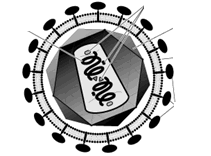
How HIV Infects Cells
HIV (Human Immunodeficiency Virus) infection involves several key steps:
-
Entry into the body: HIV primarily enters the body through exposure to specific bodily fluids, such as blood, semen, vaginal fluids, rectal fluids, and breast milk. Common transmission routes include unprotected sex, sharing needles, or transmission from mother to child during pregnancy, birth, or breastfeeding.
-
Attachment and Entry into Immune Cells: The virus targets immune system cells, particularly CD4 T cells (a type of white blood cell). It binds to CD4 receptors on the cell surface, along with co-receptors like CCR5 or CXCR4. This attachment allows the virus to fuse with the cell membrane and enter the CD4 cell.
-
Viral Replication: Once inside the CD4 cell, the virus releases its genetic material (RNA) and enzymes, using the cell's machinery to create viral DNA. This viral DNA then integrates into the host cell's DNA, effectively taking control of the cell's functions. The cell then produces new viral particles.
-
Viral Spread: Infected CD4 cells produce new HIV particles. The released viruses can infect other CD4 cells, as well as other immune system cells, spreading the infection throughout the body. As the virus replicates, it damages and destroys CD4 cells.
-
Immune Response and Clinical Latency: The immune system responds to the infection by producing antibodies and activating other immune cells to fight the virus. This phase can last for several years without noticeable symptoms, but the virus is actively replicating and causing damage to the immune system during this time.
-
Progression to AIDS: Without treatment, the continuous replication of the virus and destruction of CD4 cells weaken the immune system. As the CD4 cell count drops below a certain level and the body becomes more susceptible to opportunistic infections and certain cancers, the infection progresses to Acquired Immunodeficiency Syndrome (AIDS). At this stage, the body struggles to fight off infections and complications, leading to severe illness and potentially deat
